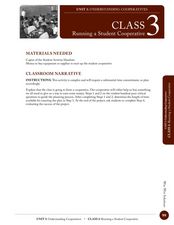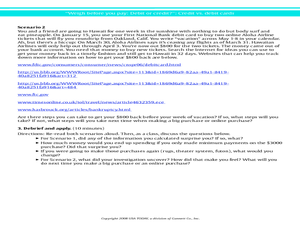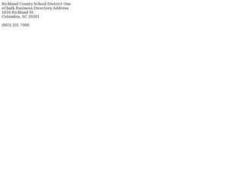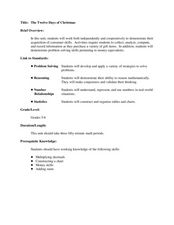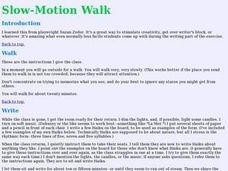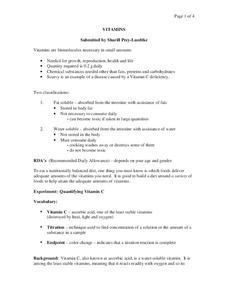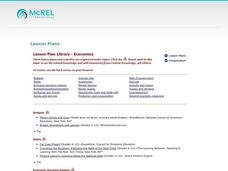Curated OER
Optimization For Breakfast
Students identify he proportion of a cereal box. In this algebra lesson, students define the relationship between patterns, functions and relations. They model their understanding using the cereal box.
Curated OER
The Good Life
Students explore the world of credit. In this finance lesson, students examine the use of credit and discuss financial fitness. Students create a brochure or poster to educate others on the types of credit and how to stay financially fit.
Curated OER
Made Round To Go Round
In this lesson students investigate what it would cost to furnish one room of their choice by shopping on the Internet. Both Australian and American dollars are to be given for each item to demonstrate the difference between two...
Curated OER
Bigger and Smaller - Exponent Rules
Students study rules regarding exponents. It uses a situation from Alice in Wonderland in which Alice's height is doubled or reduced by half depending on what she consumes to introduce negative exponents and the rules for dividing powers.
Curated OER
Running a Student Cooperative
Students form a classroom cooperative. In this service learning lesson, students explore how to form and run a cooperative and decide as a class how to implement their cooperative plan. Students use funds raised from the cooperative's...
Curated OER
Weigh Before You Pay: Debit or Credit?
Students explore the concept of debit and credit cards. In this debit and credit card lesson, students read an article about debit and credit cards. Students discuss differences between the two forms of payment. Students calculate the...
Curated OER
The Snack Bar
Sixth graders complete a purchase order. In this ratios and patterns lesson, 6th graders work in groups to complete a purchase order for a grand opening of the school snack bar. Students use rations to figure out the need and quantity...
Curated OER
Free Enterprise--Product Cost
Students apply basic math skills in computing a product cost.
Curated OER
Scientific Graphs
Students organize data collected from their experiments using graphs. For this statistics and biology lesson, students organize their scientific data from an article into readable graphs. They define the usefulness of their graph and...
Curated OER
99.86% - Measuring Our Sun's Mass
Students determine just how large the sun is. In this solar system lesson, students follow the prescribed steps to draw a box that represents the size of the sun and its mass compared to the entire solar system.
Curated OER
Banking on the Future
Students solve problems involving interest. In this investing instructional activity, students investigate the pros and cons of investing in a bank account and stocks. They differentiate between aggressive and conservative investments.
Curated OER
The Fat and the Lean
Students collect data on calorie intake. In this algebra lesson plan, students use the collection of data to make better eating decisions. They investigate the nutritional value in food using a graph and draw conclusion from their findings.
Curated OER
Give and Take
Second graders are introduced to the differences between goods and services. In groups, they discover whether a given occupation offers a good, service or both. To end the lesson, they pick one occupation that interest them, draws a...
Curated OER
Acceptance Sampling
In this algebra activity, students sample food and identify acceptance sampling. They create specific plans to meet specific situations as they sample the food. There are 6 questions.
Curated OER
The Twelve Days of Christmas
Students purchase gift items and practice collecting, analyzing, computing, and recording information. In this data lesson plan, students also complete money equivalent activities.
Curated OER
The Business of Credit
Learn about credit ratings and how it plays a role in the function of small businesses. Learners use their knowledge of good and bad credit to role play and determine good credit vs. bad credit in the area of small businesses.
Curated OER
Arranging Numbers from 1 to 5
Kindergarteners arrange manipulatives or everyday objects in groups of one through five. They identify groups seen in pictures of nature and compare same numbers of different objects.
Curated OER
Pacing a Gunther Chain
Students pace a Gunther Chain, a measurement used by foresters to determine distance and area. They discuss that pacing is individualized depending on age, gender, etc. They practice to find an average pace. Teams estimate, pace and...
Curated OER
What Time Does the Last Worker Report?
Third graders explore the concepts of time and consumer goods. In this telling time instructional activity, 3rd graders respond to questions about the passage of time and goods and services. This instructional activity incorporates the...
Curated OER
Oceanography: Ocean Market
Sstudents identify consumer goods obtained from the oceans. They classify the items and calculate the cost of buying these goods. After taking a simulated sea shopping spree, they tally the cost of the items purchased. They conclude the...
Curated OER
Vitamins
Students determine the amount of vitamin C present in 3 samples of juice stored in various light conditions. In this vitamin lesson plan, students investigate the amount of vitamin C present in juice exposed to different quantities of...
Curated OER
Micro Economics - Personal Budgeting
Students explore the real world as it relates to money and how people use it. In this money management lesson, students jump into the real world as they role play with money through spending, saving, being married, single, having...
Curated OER
Potato: A Tale from the Great Depression
Learners barter for goods within the class. For this economics lesson based on the Great Depression, the teacher introduces the lesson with a picture book, then students are allowed to barter with teacher supplied goods as they examine...
Curated OER
Applying Trigonometric Functions To Real Life
Students examine where trigonometry exists outside the classroom. For this trigonometry lesson, students create trigonometric functions to match the data provided and to solve word problems relating to the real world.






